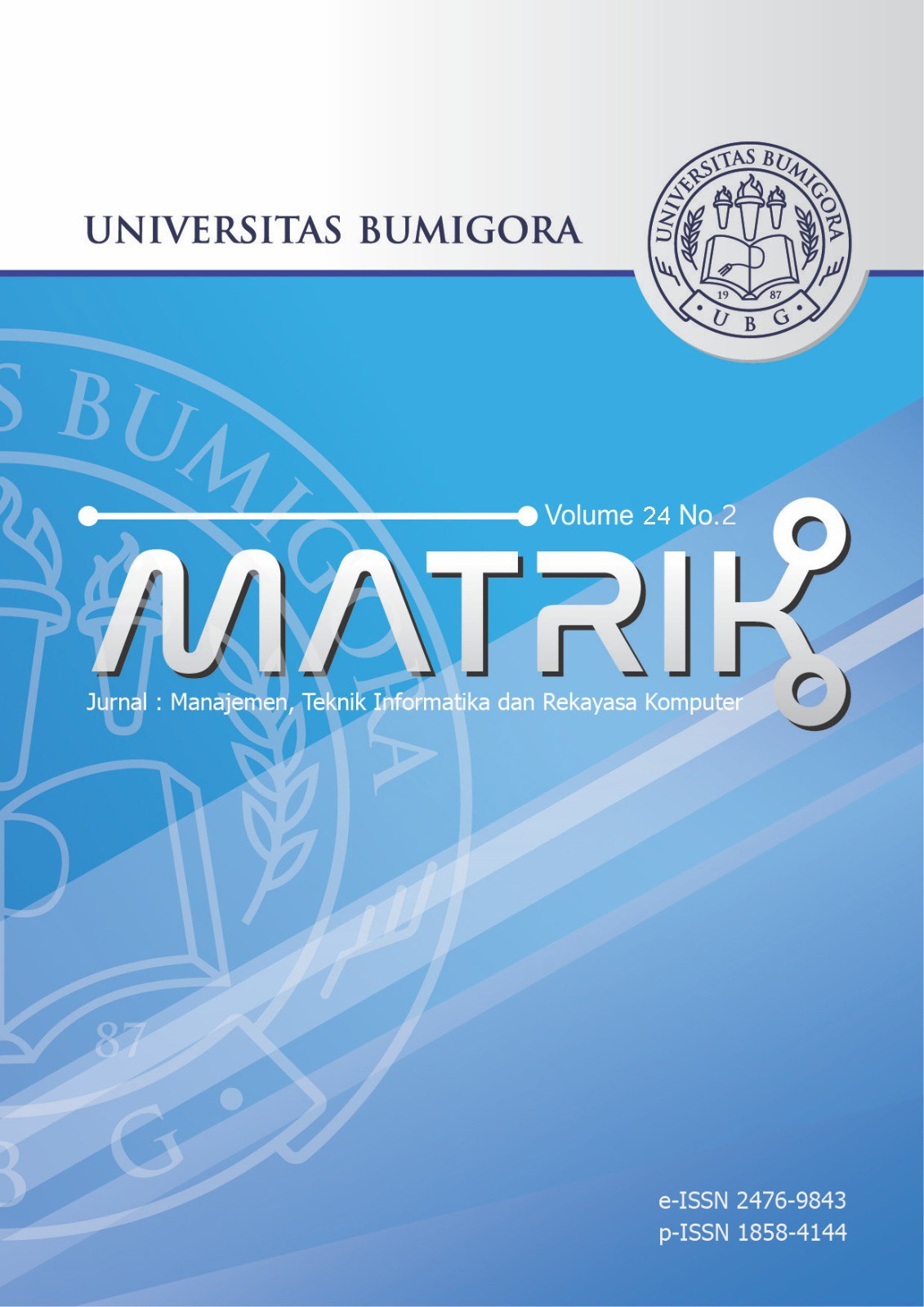Analysis of Combination Machine Learning Classification with Feature Selection Technique for Lecturer Performance Analysis Model
Abstract
Machine learning-based classification techniques are widely utilized for accurate analysis in various fields. This study focuses on assessing lecturer performance in higher education to enhance teaching standards and produce high-quality learning outcomes. Previous studies have employed multiparameter approaches, such as statistical correlation analysis, but these methods fail to achieve optimal accuracy and precision due to limited alignment with data characteristics. This research proposes a lecturer performance measurement model by evaluating three machine learning algorithms: k-Nearest Neighbors (k-NN), Decision Tree, and Na¨pve Bayes. The model integrates three feature selection techniques to improve classification performance: ANOVA, Information Gain, and Chi-Square. The study aims to enhance classification accuracy and assess the impact of feature selection techniques on performance metrics. A significant contribution of this research is introducing a dynamic feature selection approach tailored to data characteristics, which improves classification model performance. The methodology comprises three main stages: data loading and measurement of relevant parameters; data preprocessing, including filtering, cleaning, transformation, normalization, and feature selection; and performance evaluation using a machine learning-based classification approach. Experimental results demonstrate that the Decision Tree algorithm combined with Chi-Square feature selection achieved an accuracy of 0.887, precision of 0.903, recall of 0.887, and F1-score of 0.884. The proposed model
provides a reliable framework for evaluating lecturer performance and can be utilized to recognize and reward high-performing lecturers effectively.
Downloads
References
Mining Using Orange,” International Journal of Advanced Research in Science, Communication and Technology, vol. 6, no. 1,
pp. 318–324, 2021, https://doi.org/10.48175/ijarsct-1394.
[2] I. Khan, A. R. Ahmad, N. Jabeur, and M. N. Mahdi, “An artificial intelligence approach to monitor student performance and
devise preventive measures,” Smart Learning Environments, vol. 8, no. 1, 2021, https://doi.org/10.1186/s40561-021-00161-y.
[3] S. Sasmal, “Predictive Analytics in Data Engineering: An AI Approach,” International Research Journal of Engineering &
Applied Sciences, vol. 12, no. 1, pp. 13–18, 2024, https://doi.org/10.55083/irjeas.2024.v12i01003.
[4] B. Maˇsi´c, M. Dˇzeletovi´c, and S. Neˇsi´c, “Big data analytics as a management tool: An overview, trends and challenges,” Anali
Ekonomskog fakulteta u Subotici, vol. 58, no. 48, pp. 101–118, 2022, https://doi.org/10.5937/aneksub2248101m.
[5] R. Rosdiana and T. Husaen, “Analysis of Lecturer Characteristics on Lecturer Performance Through Learning Effectiveness
Case Study of Nuku Tidore University,” Sosiohumaniora, vol. 24, no. 3, p. 305, 2022, https://doi.org/10.24198/sosiohumaniora.
v24i3.36469.
[6] N. Nurmawati, A. Assagaf, and S. Sukiman, “the Influence of Leadership, Motivation, Organizational Culture, Lecturer Competence
on Lecturer Performance With Lecturer Discipline As Intervening,” IJEBD (International Journal of Entrepreneurship
and Business Development), vol. 7, no. 1, pp. 198–208, 2024, https://doi.org/10.29138/ijebd.v7i1.2640.
[7] Kasmiaty, Baharuddin, M. N. Fattah, H. Nasaruddin, Y. Yusriadi, M. I. Usman, and Suherman, “The influence of leadership and
work motivation on work effectiveness through discipline,” Proceedings of the International Conference on Industrial Engineering
and Operations Management, vol. 565, no. INCoEPP, pp. 3648–3655, 2021, https://doi.org/10.46254/SA02.20210847.
[8] E. KARAAHMETOG˘ LU, S. ERSO¨ Z, A. K. TU¨ RKER, V. ATES¸ , and A. F. I˙NAL, “Evaluation of Profession Predictions for
Today and the Future with Machine Learning Methods : Emperical Evidence From Turkey,” Politeknik Dergisi, vol. 26, no. 1,
pp. 107–124, 2021, https://doi.org/10.2339/politeknik.985534.
[9] S. Kim and E. Usui, “Employer learning, job changes, and wage dynamics,” Economic Inquiry, vol. 59, no. 3, pp. 1286–1307,
2021, https://doi.org/10.1111/ecin.12980.
[10] R. Restu and S. Sriadhi, “Lecturer Performance and its Determining Factors in a Blended Learning System During The COVID-
19 Pandemic,” TEM Journal, vol. 11, no. 4, pp. 1680–1686, 2022, https://doi.org/10.18421/TEM114-32.
[11] I. R. Suwarma and S. Apriyani, “Explore Teachers’ Skills in Developing Lesson Plan and Assessment That Oriented on Higher
Order Thinking Skills (HOTS),” Journal of Innovation in Educational and Cultural Research, vol. 3, no. 2, pp. 106–113, 2022,
https://doi.org/10.46843/jiecr.v3i2.66.
[12] M. Hasim, N. F. Umar, A. Amiruddin, and A. Sinring, “Career Commitment Based on Career Identity Diffusion among Students
in Vocational Higher Education,” Journal of Innovation in Educational and Cultural Research, vol. 4, no. 2, pp. 220–228, 2023,
https://doi.org/10.46843/jiecr.v4i2.536.
[13] A. Tahnia, H. Fitria, and A.Wahidy, “The influence of organization culture on teacher performance of elementary school,” JPGI
(Jurnal Penelitian Guru Indonesia), vol. 6, no. 2, p. 460, 2021, https://doi.org/10.29210/021071jpgi0005.
[14] N. Luh, P. Srinadi, L. Putu, W. Widhyastuti, D. P. Hostiadi, and C. Ahmadi, “Lecturer Performance Measurement Based
on Organizational Culture and Leadership Behavior Analysis Using Pearson Correlation,” vol. 5, no. 1, pp. 131–139, 2024,
https://doi.org/10.46843/jiecr.v5i1.1163.
[15] I. K. Liem, A. E. Fatril, and F. A. Husna, “Satisfaction of lecturers and undergraduate students of medical faculties in Indonesia
towards online anatomy learning during COVID-19 pandemic,” BMC Medical Education, vol. 24, no. 1, pp. 1–10, 2024,
https://doi.org/10.1186/s12909-024-05620-x.
[16] A. Helmina, Dedy Irfan, Fahmi Rizal, and Kasmita, “Development of Teaching Performance Evaluation Application for Lecturers
Using K-Nearest Neighbor Method with Manhattan Distance Approach,” JTP - Jurnal Teknologi Pendidikan, vol. 26, no. 1,
pp. 278–290, 2024, https://doi.org/10.21009/jtp.v26i1.44443.
[17] Mahpud, S. Setyaningsih, and O. Sunardi, “Improving Lecturer Performance Through Strengthening Service Leadership, Empowerment,
Achievement Motivation, And Trust in Muhammadiyah Tangerang University Lecturers,” International Journal of
Business and Social Science Research, vol. 5, no. 6, pp. 226–232, 2024, https://doi.org/10.47742/ijbssr.v5n6p2.
[18] J. Hazzam and S.Wilkins, “The influences of lecturer charismatic leadership and technology use on student online engagement,
learning performance, and satisfaction,” Computers and Education, vol. 200, no. July, p. 104809, 2023, https://doi.org/10.1016/
j.compedu.2023.104809.
[19] H. Hermansyah, A. Moeins, and Y. Zain, “The Influence of Leadership, Learning Organization, Compensation, and Work
Motivation on Lecturer Performance in the Legal Study Program at Ll3dikti Jakarta,” International Journal of Social Science
and Human Research, vol. 7, no. 04, pp. 2425–2435, 2024, https://doi.org/10.47191/ijsshr/v7-i04-25.
[20] J. Turkiewicz, A. Be¸czkowska, and R. Skroback, “The Importance of Building a Relationship Between Lecturers and Students
for Student Satisfaction with Remote Learning,” Przegla¸d Bada´n Edukacyjnych Przegla¸d Bada´n Edukacyjnych Educational
Studies Review, vol. 1, no. 41, pp. 121–138, 2023, https://doi.org/10.12775/PBE.2023.010.
[21] S. Faris, “Pengaruh kompetensi, pelatihan dan motivasi terhadap kinerja dosen tetap pada universitas prima indonesia 1,”
Agriprimatech, vol. 4, no. 1, pp. 16–24, 2020, https://doi.org/10.34012/agriprimatech.v4i1.1317.
[22] M. Milkhatun, A. A. F. Rizal, N. W. W. Asthiningsih, and A. J. Latipah, “Performance Assessment of University Lecturers:
A Data Mining Approach,” Khazanah Informatika : Jurnal Ilmu Komputer dan Informatika, vol. 6, no. 2, pp. 73–81, 2020,
https://doi.org/10.23917/khif.v6i2.9069.

This work is licensed under a Creative Commons Attribution-ShareAlike 4.0 International License.


.png)













